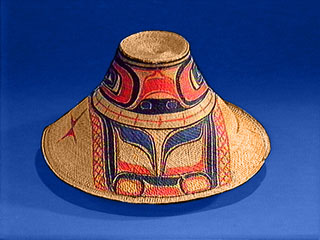Wakashan
The variety of languages within the Wakashan language group is extensive, yet its speakers occupy a relativity small area. These two characteristics of the Wakashan language group signify a long period of in-migration and local development. Languages within these group include Wet'suwet'en, Heiltsuk (Bella Bella), Nuxalk (Bella Coola), Nuu'chah'nulth (Nootka), Kwakwaka'wakw (Kwakiutl), Comox, Cowichan, Nitinat, and Songish. Individuals often spoke more than one language as trade and diplomacy required.
The hierarchical societies of the Wakashan adopted various styles of attire, dwelling, and decoration to demonstrate status. The right to display designs or symbols on dwellings and clothing is inherited or earned. Symbols indicate wealth or trading rights accorded to a family with an important ancestral lineage. These motifs, as well as songs, stories, and masks were family property.
 In the summer men wore nothing but ornaments, while women wore cedar skirts or aprons. In the cooler weather of autumn and winter, both men and women wore capes or blankets with belts and wide-brimmed hats. Blankets were woven from plant fibres, mountain goat fleece or dog hair, and decorated with symbols of ancestral lineage.
In the summer men wore nothing but ornaments, while women wore cedar skirts or aprons. In the cooler weather of autumn and winter, both men and women wore capes or blankets with belts and wide-brimmed hats. Blankets were woven from plant fibres, mountain goat fleece or dog hair, and decorated with symbols of ancestral lineage.
The women of the Pacific Coast were the only weavers in Canada and they created blankets that were highly valued in trade and as potlatch gifts. Sea otter cloaks were also highly valued. Cedar was woven into intricate designs for hats, clothes, and household goods, which adored the people and their surroundings. The outer bark of Western Red and Yellow cedar was separated from the inner bark and woven together. Cedar bark was also used in the manufacture of floor mats, funnel-shaped fish traps, or baskets. Yellow cedar is an ideal material for carving dishes, pots, and utensils. The cedar potlatch feasting bowl was a large ornamental cooking pot that was an important symbol of the clan. Cedar was also used in the construction of masks and totems.
To a family clan, the totem represented both ceremonial privileges and family identity. Figures on clan totems included the cannibal woman; the cannibal man, Bukwus; the sea serpent, Dzunkwa; the split person; and the moon, stars, and rainbow. Animal-spirits depicted were those of the owl, salmon, beaver, starfish, shark, halibut, bullhead, red snapper, mountain goat, bear, eagle, raven, frog, orca, wolf, and the most powerful, the thunderbird. These totem figures taught morality lessons or recounted an adventure that involved the ancestors of the clan. Totems were never worshipped; their power is connected with the tree felled to create the totem.
Pacific Coast art forms incorporated animals and the spirit world. These spirit-animals were representatives of a family's ancestors. Adventures or encounters with spirit beings and ancestors are the genesis and history of the family. The images depicted contain spiritual symbols whose historic significance can only be inferred. For example, the rock etchings of Sproat Lake could possibly be an expression of spirituality or an individual's aesthetic interpretation of his environment. Petroglyph art is difficult or impossible to interpret because the cultural context that surrounded the original manufacture is not always available.